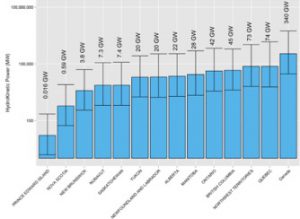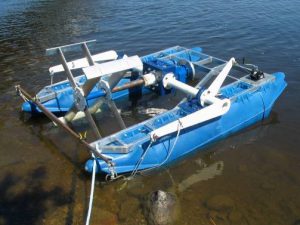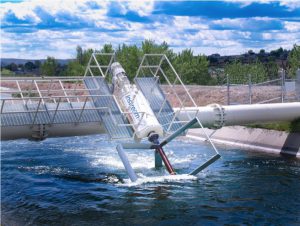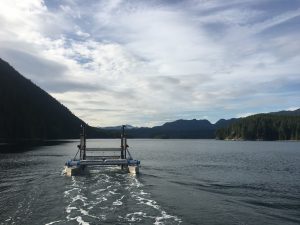River Current Energy

River current technologies harness the flow of moving water to generate power. Like tidal energy, river current produces power as a function of the volume of the water and the speed of the current.
A river current (or hydrokinetic) device is not a dam: it does not create power by holding water in a reservoir to create a height differential. Generators are installed directly in rivers, capturing the kinetic energy of water in motion.
Rivers don’t stop: they flow continuously, in one direction. This makes rivers an excellent source to meet base load supply.
Canada’s river resource is staggering: 340 gigawatts, nearly three times the total installed capacity of all electricity generation across the country. It’s also close-at-hand: many communities, both urban and remote, are located on or near rivers – with generation close to demand, infrastructure costs go down, as do transmission losses.
River current projects are already in various stages of planning, development, and operation in Alberta, British Columbia, Manitoba, the Northwest Territories, and Quebec. The technology is also suited to micro-scale developments.
River Current Technology
Like a tiny windmill under the water, a river current device is powered by the natural, kinetic flow of water. The technology is still emerging, with many different designs under development. But collectively they already show enormous promise: continuous energy supply, with low investment and maintenance costs.
Ideally, river current devices are installed in resources with relatively steady flow rates throughout the year and that aren’t overly prone to serious flooding, turbulence, or extended periods with low water levels. River current is exponentially related to water speed: as water velocity doubles, power generation multiplies by a factor of eight.
River current devices can be easily combined with existing infrastructure, including bridges and other constructed waterways (like irrigation canals and aqueducts) to create significant cost savings. Many canals are lined with concrete, contributing to higher water velocities and greater energy potential.
River current is also a compelling option for remote communities wanting to move away from diesel electricity generation. And because of their low cost and durability, river current devices have the potential to be manufactured, installed, and maintained locally – in remote communities in Canada as well as in developed and developing economies across the planet.
Strengths
River current offers many advantages, including:
- Generating power from a small resource
- Providing continuous, reliable energy production
- Extremely high capacity factors (up to 65%-95%), translating into low energy costs
- A much smaller environmental footprint than hydropower
- Seasonal synchronicity: river flows and electricity demand are both high in winter
Activity
Some of the established river current projects in Canada include:
- Idénergie, partnered with Parks Canada, to demonstrate devices in Jasper National Park (AB). In addition to the six river hydrokinetic turbines Idénergie installed in 2016, an additional 5 turbines were installed in various Parks Canada sites across Canada at approximately 0.5 kW nameplate capacity.
- New Energy Corporation has been active in developing river current energy locally and internationally. They’ve installed 5 kW turbines in Nepal and Myanmar to power off-grid communities and recently partnered with Sagkeeng First Nation in Manitoba to install a 25 kW device in the Winnipeg River.
- Verdant Power is planning a 10 MW river current project in the St. Lawrence River around the City of Cornwall and Cornwall Island.
Canadian Resource

Canada is a powerhouse in river current energy potential: initial assessments indicate a theoretical energy potential up to 340 GW. The greatest potential is in BC, Quebec, and the NWT. Further work is underway to determine optimal locations for device deployment and project development.
Research Leadership
Canada is a world leader in river current research, thanks to the Canadian Hydrokinetic Turbine Test Centre (CHTTC). The global hub for river current energy technology testing, CHTTC is a collaboration between Manitoba Hydro and the University of Manitoba, located on the Winnipeg River. CHTTC offers:
- a permitted site for the testing of river hydrokinetic technologies in a real world setting
- connection to the electrical grid using CSA standards for testing new power converters
- assistance in accelerating the commercialization process, increasing technology readiness levels (TRL) and reducing development cost through access to a shared facility
- instruments to perform studies on the impacts of flows on turbines and the impact of turbines on the environment
- critical studies on winter operations, array optimization, and integration of river current energy in remote communities to displace diesel generation
Since 2013, CHTTC has carried out over 15 deployments with device developers, including Mavi Innovations, New Energy Corporation, Jupiter Hydro, Clean Current Power Systems, and GEM Holdings, and collaborated with SMEs to provide services and innovation to the river current industry.
WATCH: Canadian river current technology developer, Idenergie, creates micro turbine
https://www.youtube.com/watch?v=75Li8XP_gfE



